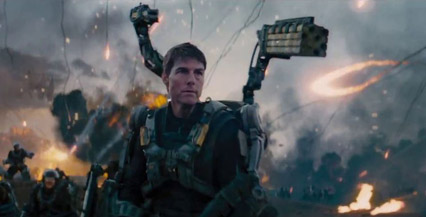Movie Review: Edge of Tomorrow
By Matthew Huntley
June 10, 2014
Edge of Tomorrow subscribes to several conventions already planted across the science fiction landscape, including the notion that the human race is on the brink of total annihilation; or supreme alien creatures with confounding fighting tactics; or high-tech weaponry that seems more bulky than strategic; and, of course, time travel. Many of the movie’s individual scenes also mirror those found in other sci-fi thrillers. In fact, there’s one in particular that seems yanked right out of Minority Report, which, coincidentally, also starred Tom Cruise. In it, Cruise’s character leads a female around in a detailed choreography so neither one of them get noticed. The difference is that in Minority Report, it was the female calling the shots; here, it’s Cruise.
You’d think that because Edge of Tomorrow rehashes so many of its ideas and sequences, it would come across as either boring or cheap, but it somehow manages to make its qualities fresh and meaningful. The reason, I think, is because in spite of all the action and special effects going on around them, the characters remain the movie’s focus. Even though we can easily sense a highly mechanized plot at work, the people seem free of it, which is actually in line with the movie’s theme that nobody’s fate is pre-determined. Such a message has also been used time and again in science fiction plots, but the filmmakers’ approach to the material seems to be that if something worked before, there’s no reason it can’t work again. Not all movies can get away with this, but Edge of Tomorrow sneaks by.
Cruise plays Major William Cage, a media relations hotshot for the United Defense Force, a global military coalition that formed when the world began fighting what has now become a five-year war with an alien species called Mimics, aptly named for their incredible agility and shape-shifting skills. Cage will be the first to tell you he played an integral role in recruiting soldiers for the UDF as well as spearheading its adoption of a metallic exoskeleton that allegedly gave the human soldiers an upper hand in a key victory at Verdun, led by Rita Vrataski (Emily Blunt), an exemplary female warrior with a not-so-friendly disposition.
Cage will also tell you he’s not a soldier and is no way ready for combat, but his new commanding officer, General Brigham (Brendan Gleeson), sees things differently. He decides to throw the smart-mouthed Cage in with the wolves during Operation Downfall, which will be the UDF’s full-scale attempt to close in on the remaining Mimics in central Europe and crush them once and for all. Cage tries to resist but he’s arrested and relegated to private under Master Sergeant Farrell (Bill Paxton), who deems him a dissenter and has no faith Cage will survive.
Farrell would be right. Shortly after Operation Downfall gets underway, the UDF learns it’s an ambush and Cage dies, but not before he kills an “Alpha” Mimic and absorbs its blood. We come to learn that such a transfusion, if you will, gives the receiver the ability to “reset” time every time he dies, which means Cage can loop back to the last time he woke up but still remember all the previous events leading up to his death. This gives him the unique ability to see the future, so to speak, but only because he’s already lived it.
I’ll not go any further into the plot, because a lot of the movie’s fun and excitement stems from Cage trying to wrap his head around exactly what’s happening to him, and the same goes for us. Cruise, as usual, makes for a convincing and likable protagonist, and he’s well matched by Blunt. Together, their characters must deliberately reset time in order to find the best way of destroying the “Omega” Mimic, which functions as the race’s entire single consciousness. As is par for the course for alien movies, when you eliminate the mother, you eliminate her offspring (again, this isn’t the most original concept).
It’s a testament to the movie’s writing, directing and acting that Edge of Tomorrow is able to be as intelligent and kinetic as it is amidst its familiar methods and presentation. Don’t get me wrong; it’s obvious a lot of time and money have gone into the action, stunts and production design, but these assets mesh with those from other science fiction movies, from the Terminator series to District 9. That’s why the film’s human and narrative elements are so important and why they should always be placed at the forefront of any story - they’re what we connect with and respond to.
Fortunately, director Doug Liman, screenwriters Christopher McQuarrie, Jez Butterworth and John-Henry Butterworth, as well as the cast, seem to be aware of this. Together, they involve us in what’s happening on-screen, and as predictable as the story may be overall, it constantly adds new layers and complications that carry weight and purpose. These help make Edge of Tomorrow a rousing and entertaining sci-fi adventure, even though it’s far from an original one.
As an aside, when I first saw the trailer for Edge of Tomorrow, I didn’t think much of it, not least because of the somewhat generic title. It left me wondering what the movie was about or why I should care about it. In hindsight, I actually appreciate the way it was cut and presented because it didn’t give anything away. This made it much easier for the movie to envelop me when I actually did see it. If anything, the trailer for Edge of Tomorrow reiterates why one should never judge a movie by one.
|
|
|
|




